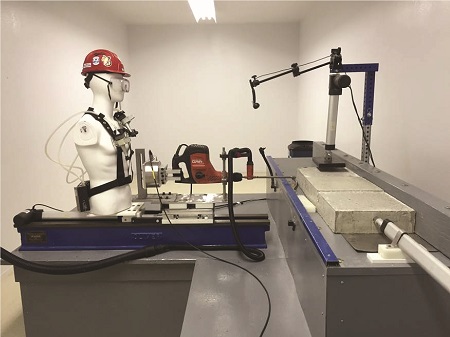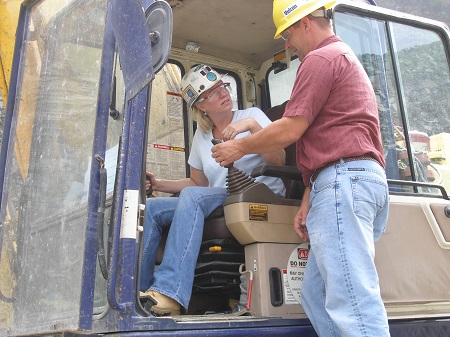Research Rounds – Volume 4, Issue 4, October 2018
NIOSH Research Rounds is a monthly bulletin of selected research conducted by researchers at NIOSH and NIOSH-funded researchers at other institutions.
Volume 4, Number 4 (October 2018)
Inside NIOSH:
Some Truck Stops Lack Healthy Options

Long-haul truck drivers routinely sleep away from home, spending long hours sitting behind the wheel. These drivers often depend on truck stops for the opportunity to sleep, stretch, get a meal, and visit the rest room. While most truck stops provide these basics, truck stops often lack exercise facilities, nutritious food, and healthcare, according to NIOSH research published in the American Journal of Health Promotion.
Long hours and large, cumbersome vehicles make it difficult for long-haul drivers to go beyond the truck stop environment to eat well and be physically active. Because these healthier lifestyle habits can decrease the risk of a host of obesity-related illnesses, including heart disease, diabetes, and cancer, truck stops with healthy facilities and food options could make it easier for long-haul drivers to maintain good health.
To learn whether truck stops provide an environment with healthy options, NIOSH researchers visited a sample of 16 truck stops in ten states nationwide, as part of the NIOSH National Survey of Long-Haul Truck Driver Injury and Health. Using a checklist they developed, researchers recorded the availability of exercise facilities, medical clinics, and restaurant and grocery store health-food options, among other features, at the truck stops and the surrounding area. For the purposes of the study, they defined facilities in the surrounding area as being visible from the truck stop and within safe walking distance or with tractor-trailer access.
Most of the truck stops studied did not provide healthy options, especially in terms of access to exercise and healthcare facilities. None offered facilities for exercise, and most (81%) lacked even a walking path. Nearly all of the truck stops (94%) lacked any access to healthcare facilities. Nutritional options were only slightly better. Restaurant and convenience store menus at half of the truck stops lacked any fresh fruit, and more than a third lacked any fresh vegetables.
Although this study included a small sample size that may not represent truck stops nationally, its findings highlight the need to increase efforts to improve the availability of healthy options for working truck drivers. Its findings can help direct these efforts by pinpointing areas that need improvement according to the researchers.
More information is available:
- John Howard, M.D., Director
- Christina Spring, Editor in Chief
- Anne Blank, Managing Editor
- Donjanea Williams, Contributing Editor
- Sarah Mitchell, Contributing Editor
- Cheryl Hamilton, Copy Editor
- Glenn Doyle, Technical Lead
- Tonya White, Technical Support
Outside NIOSH:
Research Shows How to Reduce Hazards of Concrete Drilling

Drilling into concrete can be dusty, loud, and physically exhausting. It also can expose workers to silica dust from sand and rock, which can damage the lungs if inhaled. Drilling also exposes workers to hand vibration and noise at levels well above recommended limits. Now, two NIOSH-funded studies through CPWR–The Center for Construction Research and Training and the University of California at Berkeley have identified ways to reduce these hazards.
One study used a new robotic system to measure productivity, silica dust, handle vibration, and noise, comparing these exposures in electric and pneumatic drills, which use pressurized air to operate. When testing drills without engineering controls such as a vacuum or water to reduce dust levels, investigators found similar productivity between the drills, but much higher vibration, dust, and noise levels with the pneumatic than the electric drill.
Specifically, vibration levels were more than 5 times greater with the pneumatic than the electric drill. In terms of silica dust, the pneumatic drill generated 444 times the Occupational Safety and Health Administration’s (OSHA) permissible exposure level, while the electric drill generated 11 times the OSHA level. The pneumatic drill’s noise level was also greater than that of the electric drill. To reduce these exposures to safely drill for more minutes per day, the authors recommend that workers consider using electric instead of pneumatic drills.
Using the same robotic system to evaluate drilling with bits worn to different degrees, the second study found that sharp, carbide-tipped bits produced less dust, noise, and hand vibration than dull bits when drilling into concrete. As expected, the use of a dull bit can increase the time to drill a hole by up to 60%. However, the new findings also show that a dull bit can increase noise by almost two decibels, generate about twice as much silica dust, and produce a small increase in handle vibration.
Exposures to these hazards are even greater for worn bits due to the increased time required to drill a hole. The team also found that the wear-related changes in the carbide-tip bit most closely associated with reduced productivity were reduced bit-tip width and rounding of the tip shoulders. Contractors and construction workers can check the condition of a bit by following these wear patterns. While a dust-controlling vacuum and hearing protection will still be needed for this work, the increase in productivity combined with the reduced exposure to dust, noise, and vibration makes a strong safety and business case for regularly replacing worn bits, according to the authors.
More information is available:
- Test Bench for Evaluating Concrete Drilling Methods
- UC Ergonomics Research & Graduate Training Program
- NIOSH Silica
- NIOSH Buy Quiet
- Work Safely with Silica
- NIOSH National Center for Construction Safety and Health Research and Translation
Garments Provide Varying Degrees of Protection from Spray Foam
Green construction, or building energy-efficient and sustainable structures, is in high demand. The push for more green buildings has led to construction workers using energy-efficient materials, like spray polyurethane foam insulation (spray foam). This material forms a continuous barrier on walls and corners, preventing moisture from getting inside of structures through cracks and seams. It also effectively insulates buildings to minimize the use of energy.
The issue for construction workers is that exposure to the main chemicals in spray foam, known as isocyanates, is associated with skin disorders such as contact dermatitis, skin irritation, and possible skin burns, as well as other health risks like asthma. Numerous studies support using personal protective equipment to reduce skin exposure when applying spray foam, but none focus on how the chemicals might penetrate protective garments.
NIOSH research focuses on ways to increase use of green construction practices that protect workers against this and other hazards. A NIOSH-funded study at University of Massachusetts Lowell tested protective garments that construction workers commonly wear when using spray foam. The researchers tested five different disposable garments: latex, nitrile, and vinyl gloves, and polypropylene and Tyvek coveralls, according to the study in Annals of Work Exposures and Health.
The researchers designed and used a special chemical permeation, or penetration, testing system to put the spray foam on several garments similar to how the substance is applied in real-life. They then measured the rate of permeation of various isocyanates with time. They noted the isocyanates penetrated all five garments in a linear fashion, meaning the amount of isocyanates reaching the skin was related to exposure time. However, all of the garments provided considerable protection, with some fabrics performing particularly better than others. Specifically, nitrile gloves and polypropylene coveralls provided the most protection against skin exposure to the spray foam, while latex gloves provided the least protection.
Despite the study’s findings, the researchers recommend avoiding exposure to strong chemicals, like isocyanates, as much as possible. Still, the findings could inform manufacturers about how their garments protect customers against these chemicals. The findings can also guide better choices of the types of gloves and coveralls to use in the workplace and recommend better hygiene practices. However, the researchers caution that their findings only apply to spray foams with chemicals similar to those used in their study. They recommend additional testing with other chemicals.
More information is available:
- Testing of Disposable Protective Garments Against Isocyanate Permeation From Spray Polyurethane Foam Insulation
- NIOSH Safe, Green, and Sustainable Construction
- NIOSH Extramural Research and Training Programs
- NIOSH National Center for Construction Safety and Health Research and Translation
- CPWR–The Center for Construction Research and Training
Leadership Training Developed to Help Construction Supervisors Improve Safety

Annually, thousands of construction supervisors take the Occupational Safety and Health Administration (OSHA) 30-hour outreach-training program to develop safety leadership skills. This course teaches them how to identify and control occupational hazards. However, until recently it did not include content on leadership.
To address this training gap, a NIOSH-funded project at CPWR–The Center for Construction Research and Training developed a 2.5-hour module designed to teach critical safety leadership skills. The Foundations for Safety Leadership training module focuses on five leadership skills: (1) leading by example, (2) engaging and empowering team members, (3) active listening, (4) developing team members through teaching, coaching, and feedback, and (5) recognizing team members. It consists of presentation slides, videos, case study scenarios, and facilitator and student guides.
The project, described in Safety Matters, August 2018, involved a collaboration between CPWR researchers and scientists from the University of Colorado Boulder, Leeds School of Business and University of Colorado, Anschutz Medical Campus. They worked with a curriculum development team consisting of OSHA outreach trainers, construction workers, safety and health professionals, safety climate specialists, and union representatives.
Since January 2017, OSHA has offered the new training module as an elective in its 30-hour Construction Industry Outreach Training Program, and hundreds of companies offer it as a stand-alone training course. To date, more than 10,000 construction leaders have taken the training.
This project will also be featured in the NIOSH Expanding Research Partnerships Webinar Series this November.
More information is available:
- Leadership Skills to Turn Your Foremen into Jobsite Safety Leaders
- NIOSH Construction Program
- NIOSH National Center for Construction Safety and Health Research and Translation
- CPWR–The Center for Construction Research and Training
Mention of any company or product does not constitute endorsement by NIOSH.
